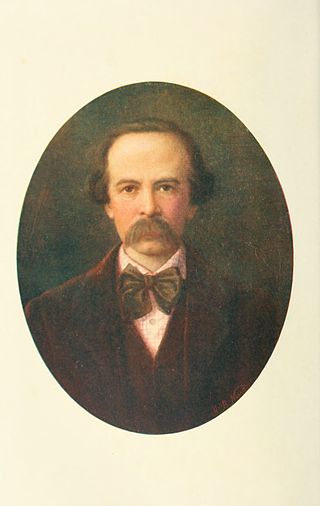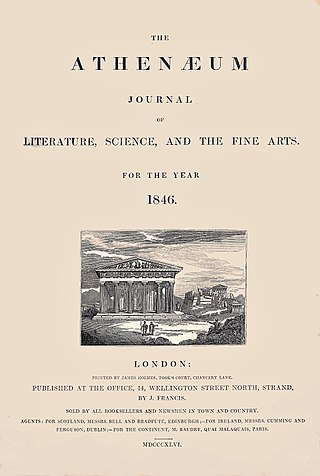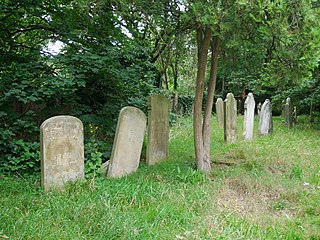
The Pines is a Grade II listed house in Putney in the London Borough of Wandsworth, it was home to the poets Algernon Charles Swinburne and Theodore Watts-Dunton. [1]

The Pines is a Grade II listed house in Putney in the London Borough of Wandsworth, it was home to the poets Algernon Charles Swinburne and Theodore Watts-Dunton. [1]

The building is at 9 - 11 Putney Hill, south of the Upper Richmond Road, Transport for London bus stop Putney Station (Stop H) is outside. [2]
The building was built circa 1870 as a pair of four-storey townhouses. [1] Theodore Watts-Dunton moved in during 1879 with his two sisters, brother in-law, and nephew. [3] [4] Watts-Dunton took in Algernon Charles Swinburne [5] until Swinburne's death in 1909. [6] Watts-Dunton and Swinburne are seen in an image at the property in 1909 [7] and a blue plaque erected by the London County Council on the house in 1926 reads "Algernon Charles Swinburne (1837–1909) poet, and his friend Theodore Watts-Dunton (1832–1914) poet, novelist, critic, lived and died here". [8] Watts-Dunton lived on at The Pines for five years after his more famous companion's death in 1909 [9] and then died there in 1914. [10]
Essayist and cartoonist Max Beerbohm frequently visited. [11] He described the house as being "but a few steps from the railway-station in Putney High Street" in his 1914 essay No. 2, The Pines., [12] and illustrated a visit in a piece in 1926. [13] Mollie Panter-Downes researched Beerbohm's visits in the book 'At the Pines' in 1971. [14]
Watts-Dunton also took in artist Henry Treffry Dunn and provided a studio for him at The Pines until his death in 1899. [15]

Putney is a district of south London, England, in the London Borough of Wandsworth, five miles southwest of Charing Cross. The area is identified in the London Plan as one of 35 major centres in Greater London.

Wandsworth is a London borough in southwest London; it forms part of Inner London and has an estimated population of 329,677 inhabitants. Its main named areas are Battersea, Balham, Putney, Tooting and Wandsworth Town.
This article contains information about the literary events and publications of 1879.

George Meredith was an English novelist and poet of the Victorian era. At first his focus was poetry, influenced by John Keats among others, but he gradually established a reputation as a novelist. The Ordeal of Richard Feverel (1859) briefly scandalised Victorian literary circles. Of his later novels, the most enduring is The Egoist (1879), though in his lifetime his greatest success was Diana of the Crossways (1885). His novels were innovative in their attention to characters' psychology, and also took a close interest in social change. His style, in both poetry and prose, was noted for its syntactic complexity; Oscar Wilde likened it to "chaos illumined by brilliant flashes of lightning". He was an encourager of other novelists, as well as an influence on them; among those to benefit were Robert Louis Stevenson and George Gissing. He was nominated for the Nobel Prize in Literature seven times.

Theodore Watts-Dunton, from St Ives, Huntingdonshire, was an English poetry critic with major periodicals, and himself a poet. He is remembered particularly as the friend and minder of Algernon Charles Swinburne, whom he rescued from alcoholism and drug use and persuaded to continue writing.

Charles Jeremiah Wells was an English poet.

The Athenæum was a British literary magazine published in London, England, from 1828 to 1921.

Putney is a constituency created in 1918. It is currently represented in the House of Commons of the UK Parliament since 2019 by Fleur Anderson of the Labour Party. Putney was the only seat that Labour gained during the 2019 general election.

Bonchurch is a small village to the east of Ventnor, now largely connected to the latter by suburban development, on the southern part of the Isle of Wight, England. One of the oldest settlements on the Isle of Wight, it is situated on The Undercliff adjacent to the Bonchurch Landslips Site of Special Scientific Interest. The main village is backed by a cliff to the north, with the Upper Bonchurch section on the clifftop halfway up St Boniface Down on the main A3055 road.
Nationality words link to articles with information on the nation's poetry or literature.
Théophile-Jules-Henri "Theo" Marzials was a British composer, singer and poet. Marzials was described in 1894 as a "poet and eccentric" by parodist Max Beerbohm, and, after writing and performing several popular songs, vanished into obscurity. His poetry is seen as an example of 19th-century aestheticism.

Charles Augustus Howell was an art dealer and alleged blackmailer who is best known for persuading the poet Dante Gabriel Rossetti to dig up the poems he buried with his wife Elizabeth Siddal. His reputation as a blackmailer inspired Arthur Conan Doyle's Sherlock Holmes story "The Adventure of Charles Augustus Milverton".

Rossetti and His Circle is a book of twenty-three caricatures by English caricaturist, essayist and parodist Max Beerbohm. Published in 1922 by William Heinemann, the drawings were Beerbohm's humorous imaginings concerning the life of Dante Gabriel Rossetti and his fellow Pre-Raphaelites, the period, as he put it, "just before oneself." The book is now considered one of Beerbohm's masterpieces.

Henry Thomas Mackenzie Bell, commonly known by his pen name Mackenzie Bell, was an English writer, poet and literary critic. He was a writer for many Victorian era publications, most especially the London Academy, and published several volumes of poetry between 1879 and 1893.

Henry Treffry Dunn (1838–1899) was Dante Gabriel Rossetti's assistant and a painter in his own right. Dunn's memoirs are a valuable source for the lives of the Pre-Raphaelites. He was paid to be Rossetti's factotum and to create copies of Rossetti's paintings. It has been said that the painting Lady Lilith in the Metropolitan Museum of Art was actually painted by Dunn and only "touched up" by Rossetti.

The Green Man is a public house in Putney in the London Borough of Wandsworth, on the edge of Putney Heath, parts of which date back to around 1700. The pub was once frequented by highwaymen and was a popular place for participants to fortify themselves before or after a duel on nearby Putney Heath.

Putney Lower Common Cemetery is a cemetery on the edge of the London Borough of Wandsworth between Putney and Barnes town centres.

Algernon Charles Swinburne was an English poet, playwright, novelist, and critic. He wrote several novels and collections of poetry such as Poems and Ballads, and contributed to the famous Eleventh Edition of the Encyclopædia Britannica.

Great James Street is a street in the Bloomsbury district of the London Borough of Camden. It has strong literary and publishing connections, and former residents include the poet Algernon Charles Swinburne and the detective story writer Dorothy L. Sayers. The Nation & Athenaeum, chaired by John Maynard Keynes, and the Nonesuch Press were both based in the street. The street has almost all its original buildings with minimal external changes. It is described in Nikolaus Pevsner's guide as "a gem" and its mostly terraced houses as "unusually uniform for their date". The majority of the street is listed by Historic England.

La Soeur de la reine is a burlesque French-language play written by Algernon Charles Swinburne in the 1860s. The comedy of the piece derives from its parody of the full-bloodedly Romantic style of Victor Hugo's prose plays, and from its portrayal of a profligate and tyrannical Queen Victoria whose numerous affairs with her prime ministers and with William Wordsworth are the scandal of the age. Though Swinburne sometimes read from the play to his friends, for whose amusement it was primarily intended, he did not publish it, and the surviving manuscripts, comprising Acts 2 and 4, were not published until 1964. It is now considered a triumph of satirical humour.
British Listed Buildings, a Good Stuff website, is an independent online resource and is not associated with any government department.
Leslie A. Marchand, Professor of English in the College of Arts and Sciences of Rutgers and editor of the Journal, discovered in 1947 in England the Symington Collection which was acquired by the Library. Among the manuscripts in that Collection were the Watts-Dunton letter books here described....During the late nineteenth century Walter Theodore Watts-Dunton was held in an amazing esteem as critic, poet, romance writer, and friend of writers...
circa 1896-1898
Coordinates: 51°27′37″N0°13′03″W / 51.4601702°N 0.217401°W